The brand-spanking new airport in Muscat was a fine sight indeed for the two weary travellers. We’d been on the go for the last day, having departed Maafushi in the Maldives in a speedboat and then onto 3 different planes from Mali, Colombo and then Dubai. We ambled like zombies through immigration where the local staff were obviously very proud of their newly built airport. We had to smile at their infectious enthusiasm and it made a great first impression of Muscat for us.
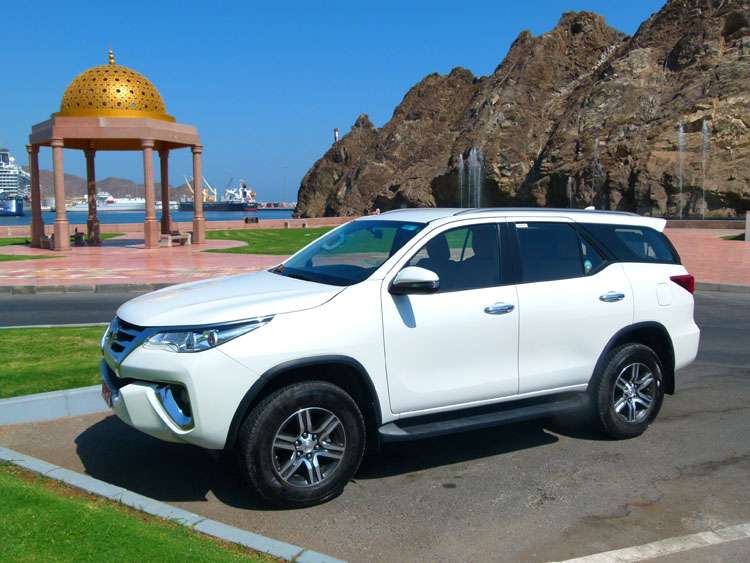
We had hired a car from the airport as we’d be driving ourselves around and camping for the next week, we just needed to go through the process of filling out the paperwork at the desk and get shown to the car. We’d asked for a Mitsubishi Pajero 4×4 as we would need to sleep in the back of it with the seats down. It was an idea I’d read while researching the trip and meant we wouldn’t have to buy and tent. The Pajero turned into a Toyota Fortuner 4×4, a lucky break for us as it had a little bit more room in the back.
This would be the first time I had driven a left-hand drive car (barring one short stint many years ago in Costa Rica). So, I had chosen to do our tour around Oman in a clockwise direction around the coast that would give me time to get accustomed to the car and the traffic before we hit the mountain roads of the Al Hajar and the drifting dunes of the Wahiba Sands.
As it was too early to book into our hotel in Al Mawaleh, near the airport, we took the time to go to Muscat City Centre, a large shopping mall near the airport with a Carrefour supermarket. We had read that the Carrefour would have camping supplies including the mattresses we would need for the back of the car. Shazz was now the navigator (courtesy of an Omantel Sim Card from the airport shop), and with Google Maps, we found our way through the super-fast Muscat traffic to the multi-storey carpark adjoining the shops.
The Carrefour has everything you could possibly need, so we changed some money, had lunch and headed for our hotel nearby. We arrived a little early, but the lovely staff had the room ready and let us in anyway. Still shattered, we showered, put on the TV, poured ourselves some duty-free rum and ate some dinner from the supermarket. Our first bed for a couple of days was well received!
Our first day on tour wasn’t going to involve too much driving, so we took our time and had breakfast around the corner at a small cafe. English is spoken widely, if not well, so it’s not too hard to get something to eat. To aid customers, signage on Omani shops are subtitled in English as well and tell you exactly what lies within. For example, a grocer’s shop will have “seller of vegetables and fruit” written on the store front under the Arabic script. This would prove very handy as we went along.
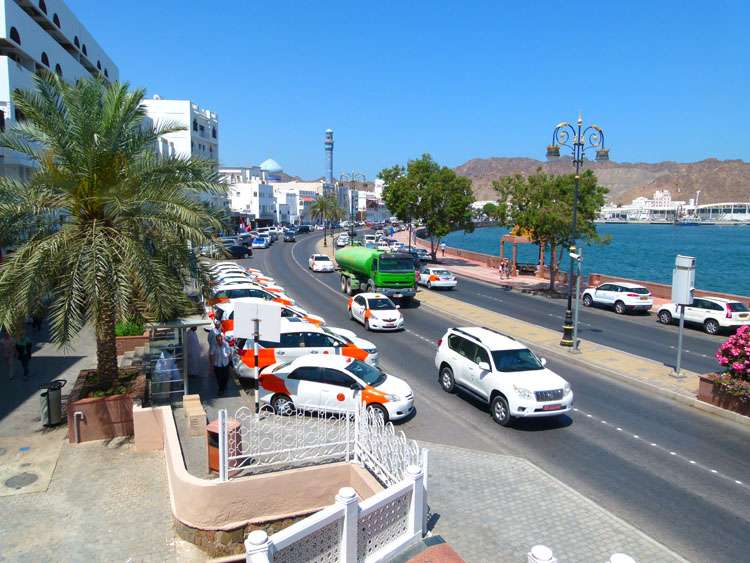
We decided to head straight to Mutrah and its famous Souq after checking out of the hotel. Traffic was thick and fast throughout the city but it flows well. The city itself isn’t that big and we had soon found our way to the seafront and got a park about a kilometre away along the seawall. The narrow lanes of the souq are jam-packed with perfumes, spices, gems, textiles and all sorts of tourist-orientated objects. Most sellers in the souq seem to be Indian and work for the Omani owners. Foreign workers do all the work the Omanis don’t want to do, so, for the country to run, there exists an interdependence that bind the locals and the foreign workers together for their mutual benefit. If you’ve ever been to Singapore, Hong Kong or Dubai you’ll have seen this relationship in action.
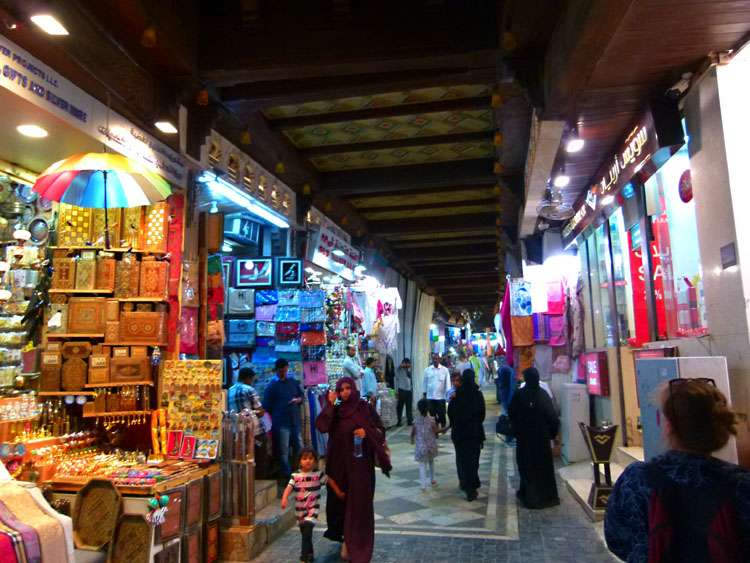
After a lap around the souq, we returned to the car and headed out on Highway 17 and down the coast to the fishing village of Quriyat. Once again we called on Google Maps to navigate us through the tight cluster of tiny lanes to the waterfront. We had lunch at a local cafe and were introduced to the local version of takeaways. Cars, especially with women drivers, pull up out the front of the cafe and blow their horns. Out goes the waiter, takes their orders and then when they’re ready, run back out and give them to the waiting drivers. The women won’t sit in the cafe with strange men, especially unaccompanied.

Even though we’d taken our time, it was still too early to find a campsite for the night. So, we decided to head to the Bimmah Sinkhole which we were going to leave till the next morning. The limestone depression is worth a quick look and is free to enter. It’s popular with locals having picnics on the weekends and holidays. It’s turquoise water is certainly inviting on a hot day, but we weren’t tempted to swim and headed back to the car after about 30 minutes.
Our first campsite was on the cliff’s edge between Bimmah and Fins. This whole section of coastline is used by fishermen and dozens of roughly hewn roads run off the coast road to fishing spots that are cleared for campsites. We reversed up the car into a clearing right on the cliff’s edge and opened up the rear hatch door. There was an old fireplace beside our park, but we didn’t want to draw any unnecessary attention to ourselves on our first night of camping, besides we were in clear sight of the road and it was a bit too windy.
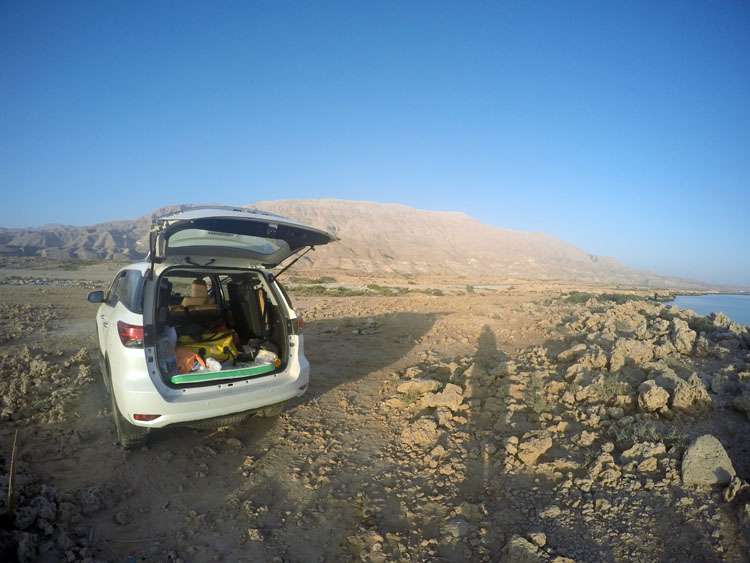
We poured ourselves a rum and made up our beds, which would remain layed out for the remainder of the trip. We watched large shoals of fish being dive-bombed by seabirds as the sun began setting and the feeling of contentment was hard to ignore.
The back of the Toyota was a bit cramped though with the hatch down and our sleep was problematic. We decided to leave it up in future and let our legs stretch out (mine at least – Shazz didn’t have any problems!).
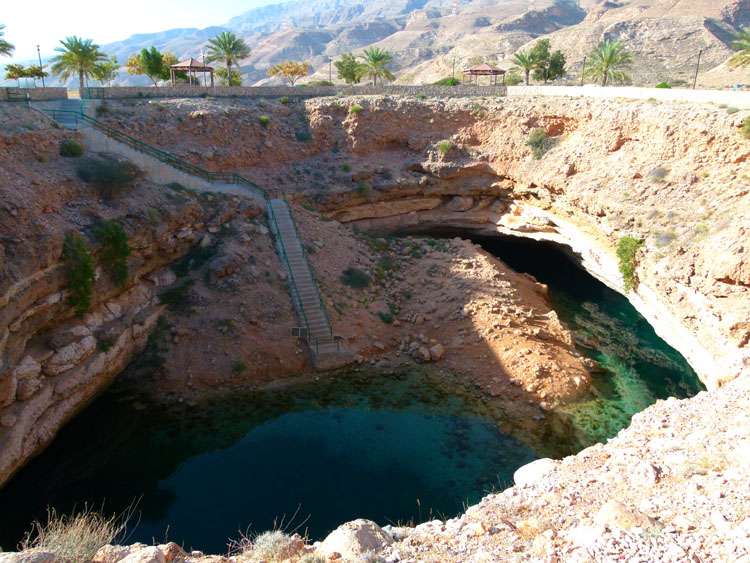
Our second morning was spent looking for a toilet. The small cafe we had breakfast at didn’t have one (probably because Sharyn was there), so we had to make a dash for the Bimmah Sinkhole again where we knew they had good, clean toilets. Day two featured the wonderful Wadi Shab, a long, narrow canyon with a flowing stream that is only one of two in the country which never dries up. The stream is fed by an underground aquifier and despite the outside heat, the water is always nice and cool to swim in.
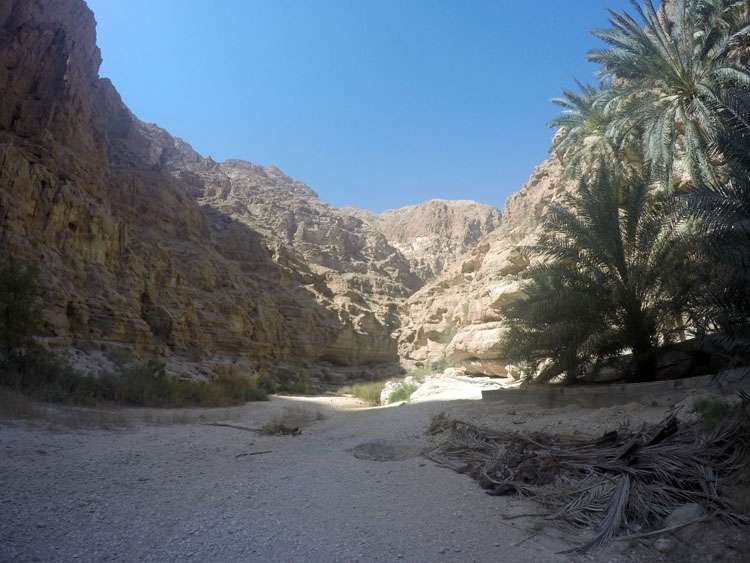
The trail begins with a boat ride to the other side of the stream which is quite wide at its outlet to the sea. The ride costs 1 OMR return for one person. The trail follows the side of the canyon, its walls climbing impressively above us keeping the canyon in shade for most of the day. About halfway up (at least 30mins) you need to scramble around giant boulders to find the trail which isn’t that well marked. We managed to loose the trail, so we had to climb around for a while to pick it back up. We found it again on the other side of the canyon following an aquaduct that the locals use to irrigate small market gardens.

The last section of the trail must be swam. A series of deep pools lead up to a narrow slot in a seemingly dead-end at the end of the canyon. You must be able to swim or at least have a buoyancy device that will keep you afloat while you make your way up to it. A narrow slot about 10m long has just enough room to keep your head above the blue green water. Claustrophobics should probably give this a miss! The reward for your curiosity is a small, well lit cavern with a small waterfall and a rope so you can hoist yourself up onto overlying boulders to take a jump into the seemingly bottomless pool.
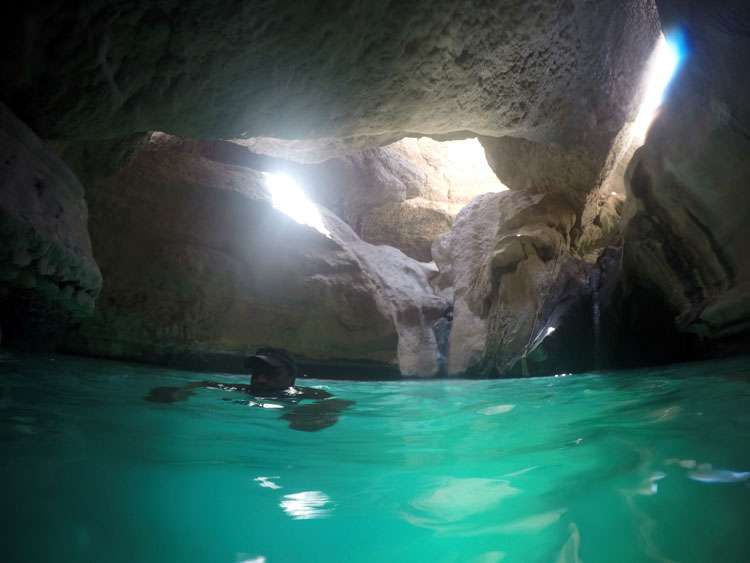
We floated around for about 20 minutes with a few other people, then swam back out and made our way back down the wadi. It was really hot by now and there were plenty of people now entering the first pool to cool off. Amazingly, so many people hadn’t brought a hat or even a water bottle for the hike. One group of Arabic women we talked to were dressed up for a night out rather than a hike. They had no water, no idea how far it was and were wearing high heels!
Back at the trail head, we bought some drinks and chatted with a few expat guys who work here in Oman in the oil/gas industry. They told us about a supermarket in Sur, our next stop, and gave us some vague directions.
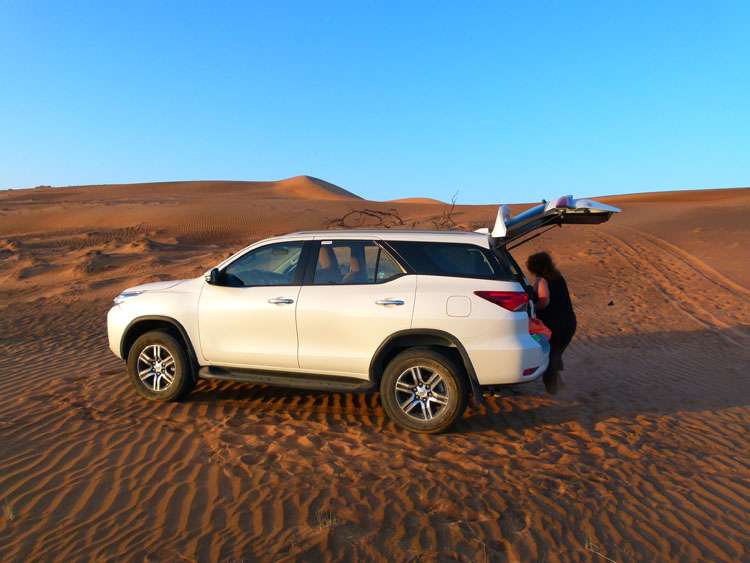
In Sur we bought some extra mattresses to level out our bed for a better night’s sleep and headed out onto Highway 23 and down to Wahiba Sands for the night. At the town of Al Kamil Wal Wafi we drove out onto a dirt road I had found on Google Maps Satellite View and headed out into the dunes. It took about 10kms before we were well and truly in the dunes and away from civilization. I attempted to drive out onto a side road and into the deep sand, but after a couple of kilometres decided better. It was getting late and I didn’t want to bog us now, with no sand mats, miles from nowhere for the night! I let air out of the tyres and turned us around, back to the harder dirt road. At the end of this road we parked the car besides a big dune for the night and took a mat and a drink and climbed to the top to watch the sunset.

We were awoken by a herd of camels passing nearby. They seemed cautious of us and gave us a wide berth. Back in town, we had breakfast and pumped up the tyres and filled up with fuel. As we decided not to visit the turtle colony at Ras Al Jinz (as it was supposedly out of season), we had an extra day up our sleeves. So today we drove up to Wadi Bani Khalid (with Wadi Shab, the only two wadis with year round water) for lunch. There’s only a short walk in from the car park to the well manicured pools. A restaurant is perched up on the far bank, overlooking the main pool. Here we had a soft drink and chatted with a guy from Salalah in the south of Oman. He kindly gave us a list of things to see and do and explained just how different Salalah was to the rest of Oman (being very green and fertile).
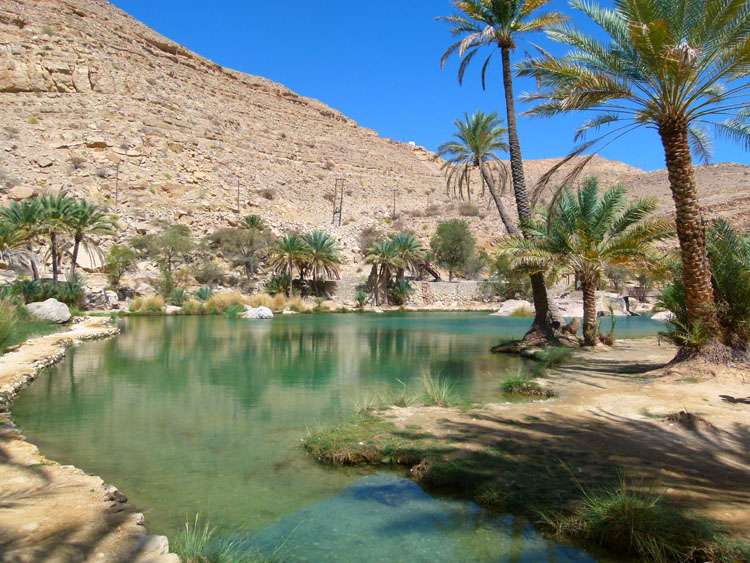
A close eye is kept on swimming attire here, as one woman found out. She was chased out of the main pool for having a one piece costume on. It seems shorts and a T Shirt are the minimum requirement here!
Getting back on the main road (Highway 23), we drove up to Ibra to find the place almost deserted. Too early to camp, and with the souqs closed, we drove around aimlessly until we stumbled across the old town, Al Munisifeh. The ancient mud brick buildings are in a sad state of repairs, crumbling away under the weight of their age. Scattered all through the buildings is a ton of rubbish that requires careful navigation so as not to trip and fall. Suitably unimpressed, we got out of the glaring heat and back into the coolness of the car air conditioning which we ran almost non-stop.
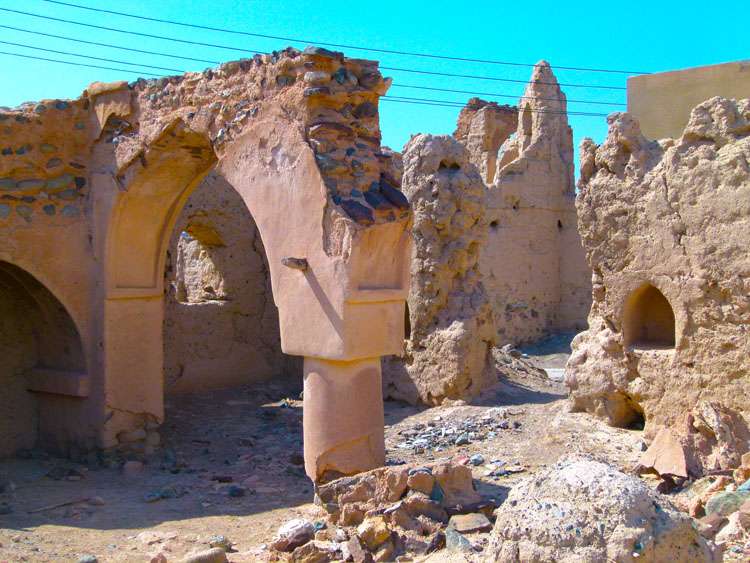
Back in town, we had to wait till 3.30pm till the shops opened up again. The three and a half hour lunch break allows everyone to eat lunch and visit the mosque for the midday prayers. We bought a few small things from a local supermarket before heading out to a campsite that I’d found on Google Maps again. It was in an old quarry outside of town, a couple of kilometres behind a giant Lulu Hypermarket. No one else ventured in there, so it was a peaceful night under a very starry sky.

The next day we cut westwards towards Nizwa but called into the old ruins at Birkat Al Mouz on the way. Once again the ruins were really ruined! and scrambling up the hill over tons of rubble didn’t appeal to us. We cut short our stay and headed to Nizwa, Oman’s second city and home to its biggest tourist attraction, Nizwa Fort and its adjoining souq. Unlike the other antiquities we’d seen, the fort had been restored to within an inch of its life! Everything was nice and neat and shiny and clean, not a thing out of place. Unfortunately, this robbed it somewhat of its character. The views from the 40m high round tower were impressive though.
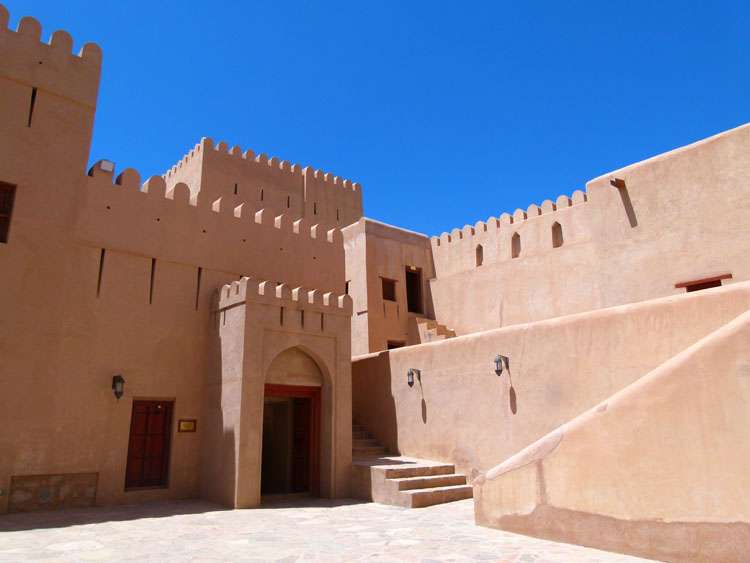
Unfortunately, my stomach had been playing up a bit for the last couple of days and I’d developed gout in my right ankle. The gout I could survive, but we decided to hire an AirBnB room for the night so I could be near a toilet.

After a quiet night and a good rest, we headed across to Al Hamra for breakfast. Al Hamra is the focal point for journeys up into the Al Hajar mountains. Our first port of call was the steep, winding drive up to the mountain village of Misfat Al Abriyyin which clung precariously to the side of an almost vertical canyon wall. Most people come up here for some hiking and getting a view of the hamlet from the other side of the canyon. With my ankle still swollen and sore, I sat and had a coffee and some local dates and chatted with a young German couple while Sharyn went for a short hike. The German couple had just finished driving the notorious mountain road that we were to do the next day. They advised caution as the road was dangerously narrow and steep as well as being unpaved. I’d read several accounts of the road, but all said the views more than paid for the angst of driving on the road. The whole reason we had driven clockwise on our route was so that I could get used to the car and any of its idiosyncrasies before taking on the mountain road.

Back down off the mountain, we took a side road up to a resort called “The View”. This was more for the practice of driving off-road than for the view. About 10kms of steep, winding dirt track tested car and driver as we got ready to drive up to Oman’s highest point, Jebel Shams, to camp for the night. The resort was nice, as was the view, but there was almost no-one there and the rooms looked rather small and boxy!
The road up to Jebel Shams is paved for all but the last 20kms. The car handled the road well for a 4 cylinder and we were soon at the Jebel Shams Resort looking for something to eat. My stomach was still giving me grief, so I relented and took an Immodium. These things have been known to block me up for 3 days at a time!
We spent an hour at the resort while the Immodium kicked in, then headed out along the canyon edge to find a camping spot to park the car. The Al Hajar mountains are known as the Omani Grand Canyon and standing on the edge looking down into the abyss you can see why. The canyon walls plunge down almost a kilometre into a wadi somewhere below, and it’s quite narrow too, the other side seemingly almost in reach of our fingertips.
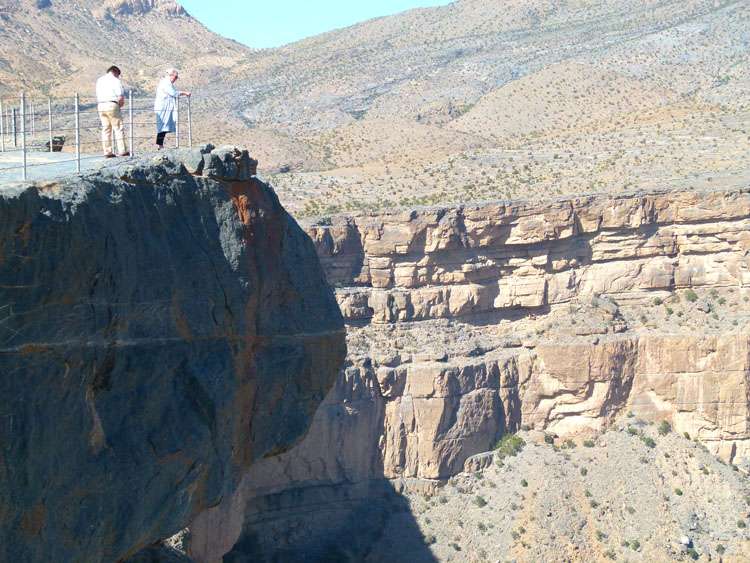
We parked the car about 20ms from the cliff’s edge and faced the rear west toward the setting sun. We were now leaving the rear hatch door open at night which kept us cooler and accommodated my feet hanging out of the back of the car. It was a lot cooler on the mountain and more comfortable for sleeping.
After watching another sunrise, we packed up the car and headed down the bumpy road to the village of Al Khitaym to do the Balcony Walk, a track which hugs the sides of the canyon wall and leading down to an abandoned village. I stayed and waited for Sharyn while she walked it alone as my ankle was still painful. She returned about an hour and a half later, just as a tour group ascended on the trail head. The rising sun shone brightly into the canyon and had already made the walk uncomfortably hot. We had judged it well and left ourselves enough time to get back down for the rest of the day’s adventures.
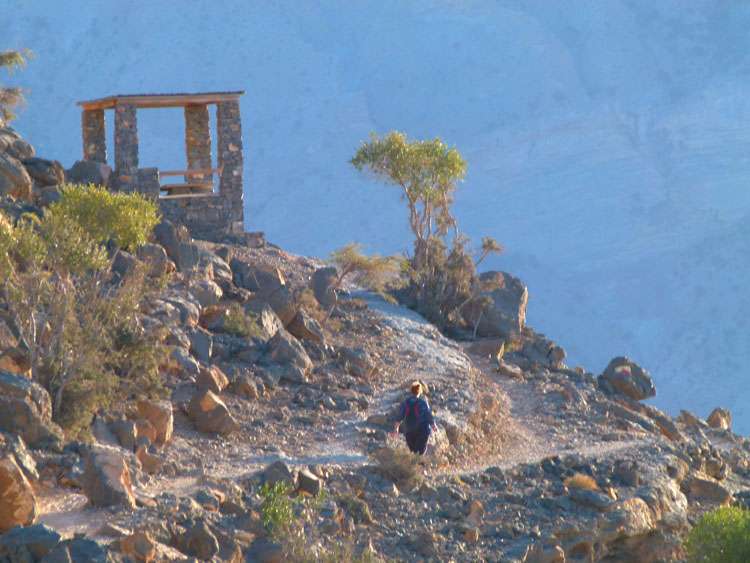
At the base of Jebel Shams is the narrow canyon of Al Nakhur. The German couple yesterday had told us it was a rough and bumpy track which goes in for about an hour to a narrow chasm. I figured we had enough time to do this and get some more 4 wheel driving in before heading to the mountain road and our last camp of the trip.

The track was indeed good practice. In fact it took quite a bit of effort and in a couple of places I got Sharyn to get out and check the road ahead. We gradually bounced our way to the chasm which was only about 10m wide, its brown, vertical walls rising above us out of sight. It was certainly worth the effort as we were completely engulfed by the canyon walls, a thin blue slit of sky streaking above us.
The time had finally come to drive the mountain road. I had had time to get used to the car and practice on some pretty rough tracks. We were both pretty quiet as we drove back through Al Hamra and out onto the mountain road.
The first 30kms, much to our surprise, was bitumen and took us up to a viewpoint. About a dozen Italian tourists were having their photos taken in a group. They were laughing out loud and shouting with joy. They had just finished the road coming from the other way. I parked the car and walked over to the edge, I sucked in a quick breath. Far below, I could see the winding sharply down into the bottom of this vast canyon, only to begin a winding climb out the other side and into the distance. I got back into the car, we looked at each other, then drove off around a sharp bend. There the bitumen stopped. In front of us a narrow dirt track dipped so steeply we couldn’t see where it was going. There were no guard rails, just a vertical drop to a certain death should you misjudge anything. I stopped and took it in. I told myself that other drivers, worse than me, had driven this road. I had to just hold my nerve, take my time and don’t make any mistakes.
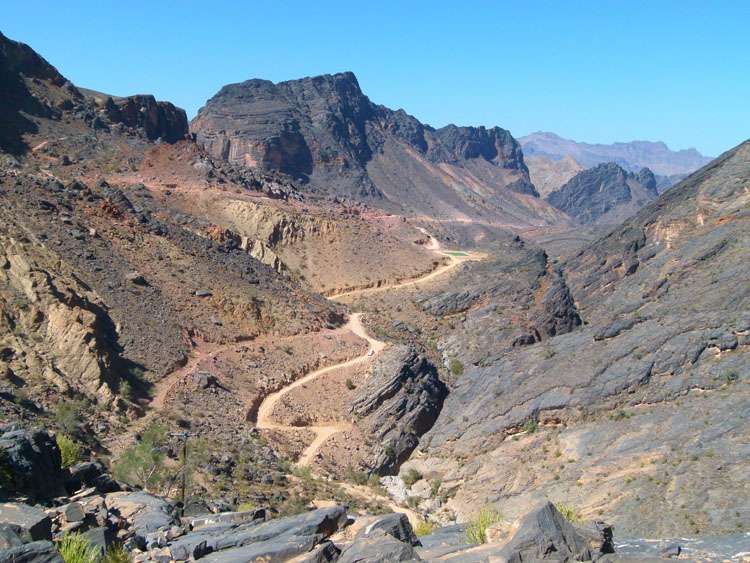
The view was outrageous – if you were game enough to look out and down! My gaze was fixed firmly on the road and anything coming up in the opposite direction. Having to pass another car up here would be a nightmare. The road became sandy in parts with difficult to negotiate hairpin bends, all the time descending way too steeply. This road is certainly not for the faint-hearted or inexperienced drivers, and I certainly wouldn’t do it in anything other than a 4 wheel drive.
Slowly, slowly we descended to a viewpoint over the picturesque village of Balad Sayt. Here a tour group blocked the road with about 10 cars. We had to get a couple to move as we couldn’t get past. The nervous-looking passengers were gratefully getting out of the cars and walking around and wondering what the hell they were doing here and would they survive to the top!

We elected not to drive down into the village as we’d been going quite slowly and weren’t sure how long it would take to drive out of the canyon and onto the bitumen again. After some time of descending sharply we bottomed out in a small wadi and crossed the stream. At last there was ground on both sides of the car! The relief was short-lived though as we could see the road rising almost vertically above us. Then the climb out began. It was so steep in parts that I couldn’t see the road over the bonnet. This caused problems when we crested hills as I couldn’t see where the road was going, or if any large rocks were in front of us.
We finally found the wadi we had chosen to camp in, but a grader had recently left a high embankment of stones on the sides of the road which made it very difficult to drive over without risking damage to the bottom of the car. We still had plenty of light left, so we elected to drive on and find another place to make our last campsite of the trip.
Driving out of the wadi, we found ourselves gratefully back on a flat road again, the precipitous canyon walls of the Al Hajar now behind us. We followed a winding road out towards Highway 10 and found a nice campsite a couple of kilometres before turning back onto the bitumen.
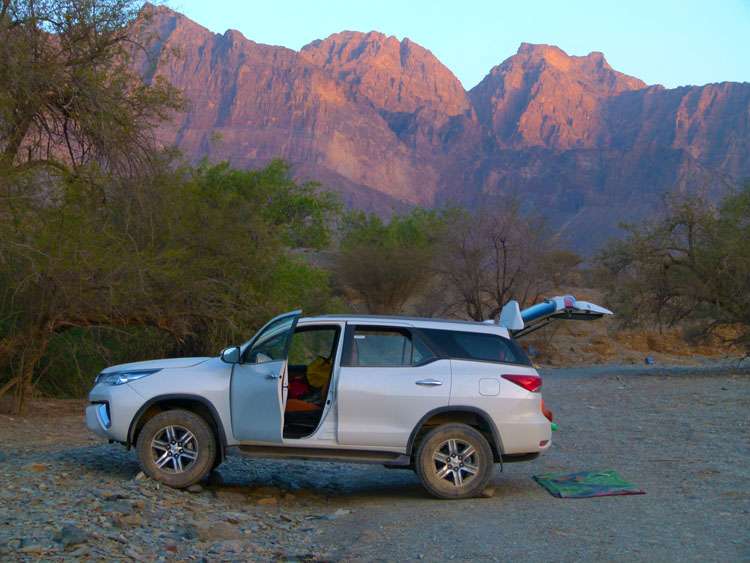
The sense of elation of completing the mountain road was palpable. I’d sweated over it for quite some time and had tried to imagine what it would be like. I’d read accounts, watched Youtube videos and looked at photos and satellite images, but nothing could have prepared me for the road itself, it was way worse than I had imagined. As I hadn’t driven a car for more than 8 years, and with limited 4 wheel drive experience, I was feeling quite proud of myself. A beer to celebrate would have been nice, but that would have to wait.
We watched the sun rise the next morning and got another early start. The road back to Muscat was awash with construction and slowed us down somewhat. It’s a dry, dusty and featureless drive, something of a letdown after the Al Hajar. Back in town we used the time to visit the Sultan Qaboos Grand Mosque in the centre of town. The mosque is relatively new but appropriately outstanding, befitting a sultan. Islamic architecture has always appealed to me from a design perspective, and this one wasn’t about to let me down. From golden domes, high tiled arches, shady porticoes and gigantic chandeliers the building radiated its importance as an icon of Oman and its people.

Back in Al Mawaleh at the hotel, we gave our bedding to the young guy behind the desk, he seemed pretty happy – and so were we! It had saved us 6 nights accommodation, which is quite a bit of money here in Oman.

Our next thing to do before leaving Oman was to get the car cleaned and returned to the airport for inspection by the rental company. The cleaners at the car wash next to Muscat City Centre Mall did a fantastic job. They spent an hour cleaning it inside and out for about AUD 12! A bargain. At the airport rental return, the guy gave it a passing glance inside and out and signed off on it – just as well, I’d just notice some scratches on the driver’s side door!
We took a bus over to Ruwi, on the other side of town, to spend the night there and catch another bus up to Dubai the next morning. Our Oman experience was over and we enjoyed it immensely, but we still have a lot in front of us still and we’re keen to get back on our bicycles for our trans America trip.
Ideally we’d have loved to have more time in Oman and see more. There’s a lot of variety of things to do and see here. From beaches with turtles and craggy cliffs, to endless sand dunes and the Grand Canyon of Arabia, Oman has plenty to offer.
HANDY HINTS:
If you plan on visiting Oman anytime soon, here’s some things that will help you to save time and money and, hopefully, make you stay more enjoyable and stress-free.
Muscat:
Oman now has Electronic Visa On Arrival at their brand new airport.
Buses are hard to work out and, depending on where you’re staying, you’ll need to do some serious research. Still way cheaper than a taxi.
From the airport, be sure to get in a SMALL taxi (if you can), they are half the price of a larger taxi/people carrier.
Sultan Qaboos Grand Mosque – Go on a weekday and go early to avoid hordes of tourists – seriously!!!
If you’re hiring a car and driving yourself, try and get it from the airport. This will make getting around more convenient and you’ll save yourself a big taxi fare!
There is a Carrefour supermarket in the Muscat City Centre Mall at the end of the airport. It has just about everything you’ll need if you’re self-catering and camping.
If you take the car to the Mutrah Souq (recommended), there is a free car park about a kilometre past the souq on the seafront.
The Omantel simcard worked quite well for us.
If you’re visiting the Mountain Road in the Al Hajar mountains, you’ll need nothing less than a 4 wheel drive – trust me!!!
If you can get Google Maps on your phone, you won’t need to hire a GPS when you get your car.
Quriyat:
You can get lunch/dinner on the seafront.
You can camp anywhere along the coast between Bimma and Fins. It’s a popular spot for locals to camp and go fishing and has many purpose-built pull-ins to park next to the cliffs. Sunsets are amazing!
Wadi Shab:
GO EARLY!! and avoid the crowds. Take plenty of water, a hat, a water-proof sack and sunscreen. Oh! and a decent pair of walking shoes (I wore my Crocs, they acted as a floatation device when I was swimming in the waterholes).
Wahiba Sands:
From Sur, follow highway 23 to Al Kamil Wal Wafi, and follow the road opposite the old fort museum, around a double round-a-bout and East out of town (check Google Maps). After about 10kms on a good dirt road, there’s a big hill that rises in front of you. Drive to the top of the hill and turn right onto the dunes. There’s a good spot here about 200m in with views.
Remember to lower your tyre pressure to about 23-25psi before driving onto the dunes.
Take plenty of water.
It gets a bit windy at night.
There are service stations back in Al Kamil Wal Wafi on the main road to pump up your tyres, refill with petrol and get some breakfast the next morning.
Wadi Bani Khalid:
Once again, arrive early if you can.
You can eat, drink and use the toilet at the restaurant.
If you ladies want to swim (and why wouldn’t you?), you’ll need at least a T-Shirt and shorts.
You can camp south of Ibra near the Lulu Hypermarket. Follow the wadi in on the north side of the buildings about 3kms into an old quarry.
Take a shortcut below Ibra Main Hospital to get to Highway 33 and Nizwa (via Birkat Al Mouz).
Nizwa:
The fort and souq are worth a visit. Hours are 9am – 4pm Sat to Thu and 8am to 11am on Fridays (Holy Day). There’s plenty of souvenirs, spices, food and clothing. There’s a goat market on Thu’s and Fri’s from 7am till about 8.30am for a taste of local colour.
Al Hamra:
This is more conservative than other places in Oman and men should be wearing long pants.
It’s a good spot for breakfast and you can pick up dinner for Jebel Shams.
Don’t miss Misfat Al Abriyyin just outside of town. There’s some good hikes and an awesome view on the south side of the village just past the mosque.
Jebel Shams:
You can camp anywhere next to the canyon wall just after the Jebel Shams Resort. Be early though.
It can get quite cold and windy up there at night.
Keep driving along the road for a couple of kms to the last village of Al Khitaym and the trail head of the Balcony Walk (W6 Route). The hike is best done in the early morning (to avoid the crowds), or in the early evening (to avoid the heat of the day and watch the sunlight setting on the far side canyon wall).
Back down the bottom (on your way back to Al Hamra), drive down Wadi Ghul to Al Nahkur (4×4’s only!).
Al Hajar Mountain Road:
The first 30kms is bitumised until you come to the viewpoint (amazing view).
The next 10kms is a very steep descent. It’s sandy in places and definitely 4×4 only!!!
There was a good camp spot just east of Al Mahada on your way out.




